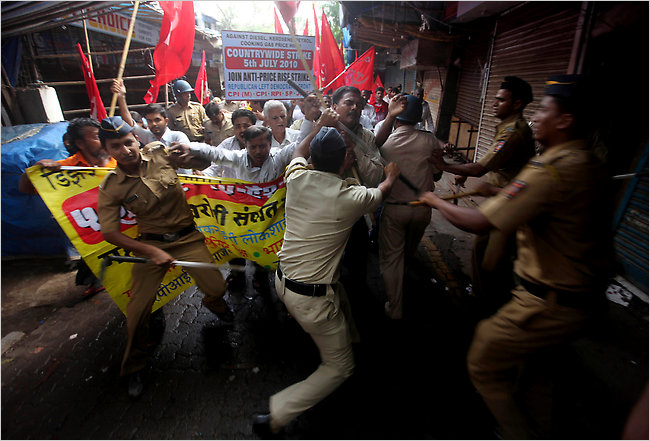
The Indian government’s decision to raise fuel prices last month resulted in some opposition-led large scale protests on Monday.
The effects of the protests were stronger than expected, with markets, schools, airports and businesses closing down across India and thousands arrested as violence erupted in some cities.
The decision to cut or reduce fuel subsidies was an attempt by the Congress-led coalition government to introduce reforms aimed at reducing India’s burgeoning deficit, set to hit 5.5% of the GDP later this year. There are fears that the move could stoke the country’s inflation, which has already put a squeeze on household budgets.
Reuters reported that the success of the strike was uneven across the country, with a total shutdown in opposition-ruled states but business as usual in regions ruled by the Congress party.
Many newspapers commented on the irony that the strikes had brought together India’s left and right-wing parties, who see the angst caused by rising prices as a perfect political opportunity.
Business organizations rushed to calculate the cost of the strikes, with estimates ranging from $641 million to $2.1 billion. On the pro-business Wall Street Journal, an oped lambasted the use of such strikes by political parties as “a program of tire burning, stone pelting and bus torching.” Describing the protestors as “mobs of placard-waving, slogan-chanting men,” the author said:
“…unlike in most democracies, much of India’s political class represents values at odds with the most productive element of society: the educated middle class. Where the middle class seeks order, the political class thrives on chaos. Where the middle class values hard work and thrift, the political class is synonymous with theatrics and public theft. Where the middle class dream is built on an education, a career in politics usually takes flight on a famous last name.”
Meanwhile, the more left-leaning Outlook Magazine lamented that despite the pain of high prices, today’s protests were a weak imitation of those in the past. The publication interviewed several families to show how rising prices, without correspondingly increasing wages, were squeezing middle class and poor households. The magazine also helpfully included a graphic (right) that illustrated the high costs of basic necessities today, in comparison with five years ago.
Will the protests work? Although the government has pledged to stand firm, more such protests could have them running for political cover and reversing their decision. After all, this is a country where the price of an onion once toppled the government.